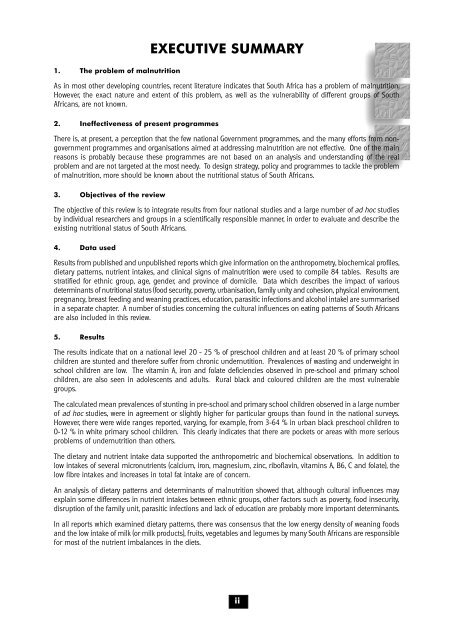the nutritional status of - Health Systems Trust
the nutritional status of - Health Systems Trust
the nutritional status of - Health Systems Trust
Create successful ePaper yourself
Turn your PDF publications into a flip-book with our unique Google optimized e-Paper software.
1. The problem <strong>of</strong> malnutrition<br />
EXECUTIVE SUMMARY<br />
As in most o<strong>the</strong>r developing countries, recent literature indicates that South Africa has a problem <strong>of</strong> malnutrition.<br />
However, <strong>the</strong> exact nature and extent <strong>of</strong> this problem, as well as <strong>the</strong> vulnerability <strong>of</strong> different groups <strong>of</strong> South<br />
Africans, are not known.<br />
2. Ineffectiveness <strong>of</strong> present programmes<br />
There is, at present, a perception that <strong>the</strong> few national Government programmes, and <strong>the</strong> many efforts from nongovernment<br />
programmes and organisations aimed at addressing malnutrition are not effective. One <strong>of</strong> <strong>the</strong> main<br />
reasons is probably because <strong>the</strong>se programmes are not based on an analysis and understanding <strong>of</strong> <strong>the</strong> real<br />
problem and are not targeted at <strong>the</strong> most needy. To design strategy, policy and programmes to tackle <strong>the</strong> problem<br />
<strong>of</strong> malnutrition, more should be known about <strong>the</strong> <strong>nutritional</strong> <strong>status</strong> <strong>of</strong> South Africans.<br />
3. Objectives <strong>of</strong> <strong>the</strong> review<br />
The objective <strong>of</strong> this review is to integrate results from four national studies and a large number <strong>of</strong> ad hoc studies<br />
by individual researchers and groups in a scientifically responsible manner, in order to evaluate and describe <strong>the</strong><br />
existing <strong>nutritional</strong> <strong>status</strong> <strong>of</strong> South Africans.<br />
4. Data used<br />
Results from published and unpublished reports which give information on <strong>the</strong> anthropometry, biochemical pr<strong>of</strong>iles,<br />
dietary patterns, nutrient intakes, and clinical signs <strong>of</strong> malnutrition were used to compile 84 tables. Results are<br />
stratified for ethnic group, age, gender, and province <strong>of</strong> domicile. Data which describes <strong>the</strong> impact <strong>of</strong> various<br />
determinants <strong>of</strong> <strong>nutritional</strong> <strong>status</strong> (food security, poverty, urbanisation, family unity and cohesion, physical environment,<br />
pregnancy, breast feeding and weaning practices, education, parasitic infections and alcohol intake) are summarised<br />
in a separate chapter. A number <strong>of</strong> studies concerning <strong>the</strong> cultural influences on eating patterns <strong>of</strong> South Africans<br />
are also included in this review.<br />
5. Results<br />
The results indicate that on a national level 20 - 25 % <strong>of</strong> preschool children and at least 20 % <strong>of</strong> primary school<br />
children are stunted and <strong>the</strong>refore suffer from chronic undernutition. Prevalences <strong>of</strong> wasting and underweight in<br />
school children are low. The vitamin A, iron and folate deficiencies observed in pre-school and primary school<br />
children, are also seen in adolescents and adults. Rural black and coloured children are <strong>the</strong> most vulnerable<br />
groups.<br />
The calculated mean prevalences <strong>of</strong> stunting in pre-school and primary school children observed in a large number<br />
<strong>of</strong> ad hoc studies, were in agreement or slightly higher for particular groups than found in <strong>the</strong> national surveys.<br />
However, <strong>the</strong>re were wide ranges reported, varying, for example, from 3-64 % in urban black preschool children to<br />
0-12 % in white primary school children. This clearly indicates that <strong>the</strong>re are pockets or areas with more serious<br />
problems <strong>of</strong> undernutrition than o<strong>the</strong>rs.<br />
The dietary and nutrient intake data supported <strong>the</strong> anthropometric and biochemical observations. In addition to<br />
low intakes <strong>of</strong> several micronutrients (calcium, iron, magnesium, zinc, rib<strong>of</strong>lavin, vitamins A, B6, C and folate), <strong>the</strong><br />
low fibre intakes and increases in total fat intake are <strong>of</strong> concern.<br />
An analysis <strong>of</strong> dietary patterns and determinants <strong>of</strong> malnutrition showed that, although cultural influences may<br />
explain some differences in nutrient intakes between ethnic groups, o<strong>the</strong>r factors such as poverty, food insecurity,<br />
disruption <strong>of</strong> <strong>the</strong> family unit, parasitic infections and lack <strong>of</strong> education are probably more important determinants.<br />
In all reports which examined dietary patterns, <strong>the</strong>re was consensus that <strong>the</strong> low energy density <strong>of</strong> weaning foods<br />
and <strong>the</strong> low intake <strong>of</strong> milk (or milk products), fruits, vegetables and legumes by many South Africans are responsible<br />
for most <strong>of</strong> <strong>the</strong> nutrient imbalances in <strong>the</strong> diets.<br />
ii
















